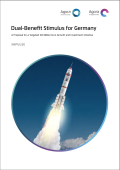
This report details recommendations for a stimulus package in response to COVID-19 that boosts economic growth and moves the economy towards climate neutrality.

The German government, through the German Federal Environment Agency, commissioned a consortium consisting of NewClimate Institute, Germanwatch, and the 2° Investing Initiative to explore criteria to measure the alignment of investment and financing with the 2°C limit.
The resource, National Alliances for Buildings and Construction: Long-term partnerships for the energy transition synthesises existing experiences of five national alliances in France, Germany, Mexico, Morocco and Tunisia, and proposes recommendations for the establishment of more national alliances to create the momentum needed to achieve low emission, resilient and efficient building.
This report aims to: (1) Understand the perceived benefits and risks, including ethical issues, as well as the levels of acceptance and support for joint projects in renewable energy (concentrated solar power and wind energy projects) among the public in various EU countries; (2) Understand the motives for potential rejection of cooperation mechanisms; and (3) Explore the determinants of public acceptance and support for cooperation mechanisms. It examines public perceptions of two potential joint projects set up under the Renewable Energy Directive in Spain, Germany, the Netherlands, and Romania.
This report Climate and energy investment map in Germany: Status report 2016 presents a map illustrating the volume of climate and energy investment flows – from the financing sources, through the intermediaries and financial instruments, to the recipient sectors (i.e. agriculture, buildings, energy, industry, and transport sectors).
